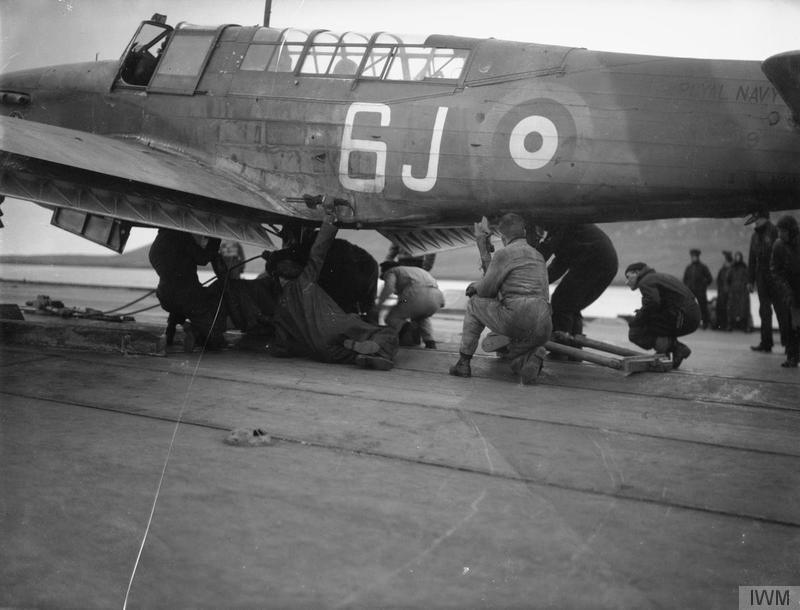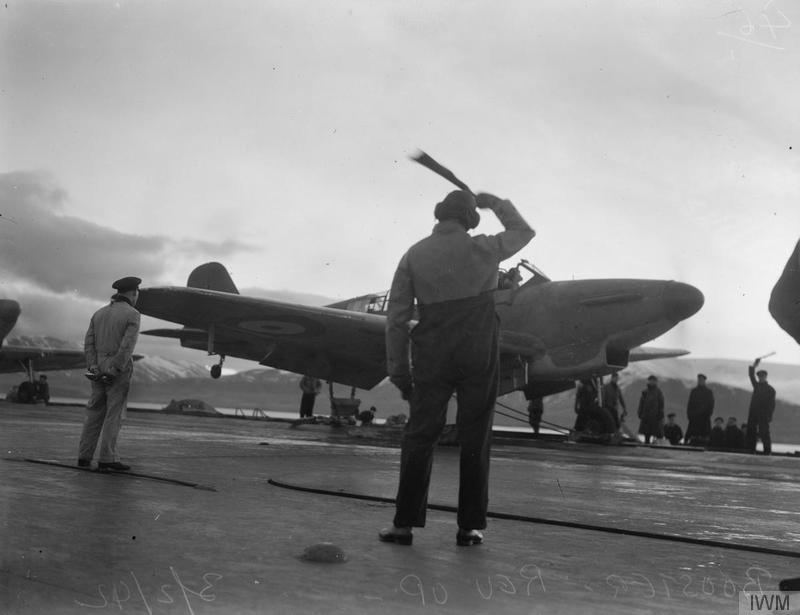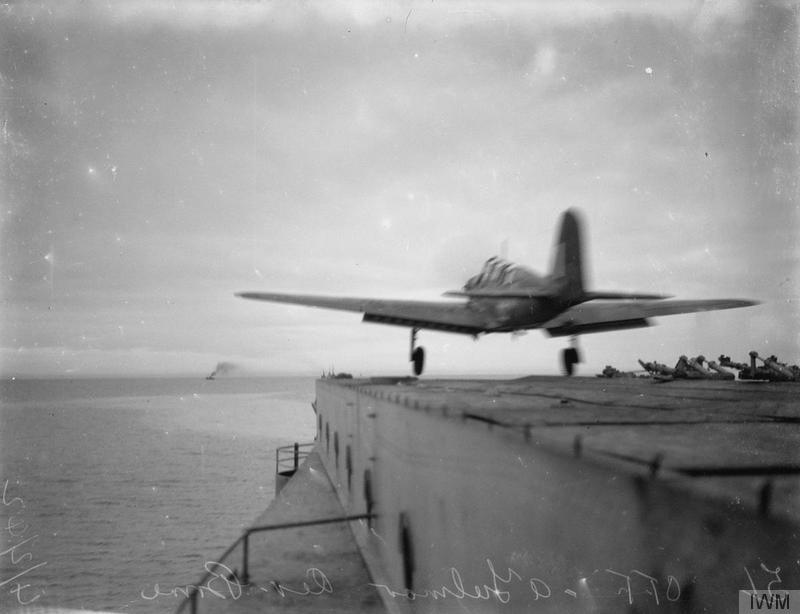“It was unfortunate that Captain Slattery came on the scene as Director of Air Material too late to influence the specification of the fighter aeroplane which had already been ordered from Fairey Aviation. This was the Fulmar, with an inline Rolls-Royce engine and sensibly designed wide undercarriage for deck landing. But of course and inevitably the machine was spoilt as a fighter by the Admiralty insisting on the provision of a rear cockpit for an observer. This made it too large, too heavy and therefore too slow but, other than all that, it was a nice aeroplane to fly and rather like the Hurricane in appearance.”
The Fulmar Mk I
Rising international tensions, including the Munich Crisis in September 1938, prompted the Royal Navy to boost its order for the new fleet fighter to a total of 250 machines. Fairey, also finishing off design work for the new Albacore torpedo bomber, broke the bad news that the first Fulmar would not likely be ready until March 1940. Production, it insisted, would be as high as 25 per month.
The delay had serious implications. The fleet desperately needed fighters as war was clearly imminent.
As a stop-gap, the Fleet Air Arm issued an emergency order for 60 single-seat Gloster Sea Gladiators and arranged for the loan of a further 38 Gladiators from the RAF.
The first Fulmars were treated as prototypes and put through comprehensive testing. The fleet fighter – straight off the production line - was found to have a maximum level speed of about 265mph at 7500ft. In operational conditions, top speed proved to be 247mph at 9000ft.
While expected to have a low rate of climb, the fighter’s unexpectedly heavy 10,000lbs dragged its performance down to a disappointing 1200 feet per minute. The labouring Fulmar would take 15 minutes to reach 15,000ft.
While the specified service ceiling was much higher, the Fulmar in operational conditions was found to have an effective maximum height of about 16,000ft.
The excess weight was to prove to have one unexpected but important benefit. The Fulmar would gain speed rapidly in a shallow dive, and the strengthened airframe maintained suitable control up to 450mph. This was to provide the Fulmar’s limited but much needed capacity to deal with faster bombers and even fighters.
Total endurance was about four hours 45 minutes, equalling four hours operational endurance (plus combat reserves). While lower than the design requirement, this was at least double that of any other known single-engined fighter.
What was impressive, however, was the aircraft’s strength and ammunition capacity. It carried 750 rounds per gun. The Hurricane carried only 334 rounds per gun.
The main fuel tank was armoured and self-sealing. It was positioned between the two crew positions. The pilot had a bullet-proof windscreen, but no armoured seat. The Observer was unprotected.
Letter from First Lord of Admiralty to Minister of Aircraft Production
[ADM 1/ 12575] 26 May 1940
Fairey Fulmar production priority2. I am informed that this type is already six months late on the original forecasts given to the Admiralty. At the moment the Navy have no 8-gun fighters in service, the most modern type being the Skua. This has a poor performance by modern standards, has only 4 guns and has been out of production for some time.
3. It is most important that the Fleet should have good fast carrier-borne fighters for their protection, which are capable of driving off shadowing aircraft and engaging shore based bombers, which the Skuas cannot do. Moreover, these fighters, operating from an aircraft carrier, may play a considerable part in the defence of these shores.
4. I fully appreciate the urgent need for accelerating the production of R.A.F. fighters and bombers and we are anxious to help as much as we can by not pressing our requirements unduly. I learn, however, that Fleet Air Arm aircraft do not appear at all in the priority list which has been sent out to the Industry. In such circumstances it seems inevitable that the production of aircraft for the Admiralty will suffer severely.
Letter from Minister of Aircraft Production to First Lord of Admiralty
[ADM 1/ 12575] 27 May 1940
Priority for Fairey Fulmar and Fairey Albacore production... But as things stand at present, the indications are that the priority decisions I have already taken do not do enough to meet the hourly need of the R.A.F. in battle. And I may have to put even more effort into two out of the five first priorities at the expense of the rest...
Feedback on the Fulmar was mixed.
It had an excellent forward and downward view, making it one of the easier single-engined aircraft to land on a carrier deck. It had no unexpected handing quirks and had light and responsive controls.
Criticism was expectedly directed at its performance which was substandard in comparison with modern land-based fighters.
It also was not fitted with any capability to carry the 250lb or 100lb bombs as specified by Admiralty requirements.
One of the first Fulmars was paired with the first of Britain’s new armoured carriers, HMS Illustrious, as the ship underwent its own initial deck trials. On June 3 1940 a Fulmar flew off and on the new carrier as it rushed between docks for pre-acceptance tweaks and calibrations.
While a fast-tracked design from the outset, the Fulmar nevertheless arrived in front-line service some six months later than originally anticipated. The first operational squadron – 806 aboard HMS Illustrious in September 1940 – was a welcome addition to the fleet.
By the end of 1940, 159 Fulmars in four front-line squadrons had rolled off the production lines at Fairey’s Stockport factory.
“It was to be said of the handsome Fairey monoplane that it lacked the fighter’s first essential - speed. There is no gainsaying that it was slow by then contemporary land-based single-seat fighter standards, but it was not short of other qualities and, if incapable of taking on a Messerschmitt Bf 109 on anything like equal terms, its advent was, in so far as the Fleet Air Arm was concerned, very welcome indeed.”
Fairey Fulmar MkII
As the first Fulmars began working-up in 806 squadron, Fairey submitted plans for a new Mark.
This variant would have the new Merlin 30 which was also now proposed as the delayed Barracuda’s power plant. Such commonality was considered important. The maintenance and spares advantages were attractive, as was the promised improvement in performance.
The Fulmar II was also to be somewhat lighter: 350lbs of savings had been identified.
The changes also would allow the specified bomb load of 500lbs, something the Fulmar I could not carry, to be achieved. It would never carry such bombs in anger.
The Mk II would also carry 1000rpg for its eight 0.303in guns, but this would do little to improve the fighter’s striking power against the increasingly heavily built German aircraft being encountered – especially when only one pass was likely given the Fulmar’s speed.




The first Fairey MkII rolled off the production line in January 1941 after 154 Mk Is had been produced. Other production lines began converting Mk I machines to the new Mk II specification. Production ended in December 1942 after a total of 600 machines had been built.
The outcome of the upgrade was somewhat disappointing. Testing showed it had slightly greater speed at all heights, achieving 260mph at 9000ft.
Rate of climb was improved: It now took 12 minutes to reach 15,000ft.
The practical service ceiling remained about 16,000ft instead of the advertised 23,900ft – too low to engage the newer reconnaissance aircraft being introduced by the Luftwaffe and Regia Aeronautica.
Endurance was also extended to five hours and 30 minutes (with combat reserves) when fitted with the new 60gal external drop tank.
“We found that the Fulmar , compared with the Hurricane, was a very staid old thing on the approach to land. Once trimmed into the approach, it would sometimes stay there. The visibility over the nose was not as good as in the Hurricane and for this reason, and because we could not get the same number of visual cues when landing it as in a Hurricane, we tended to obey the batsman more.”
Operational Notes
“This monstrous aircraft turns out to be constructed like a battleship, to weigh 9000lb, and to have an enormous rear cockpit compartment with room for a dozen “lookers”, each armed with a wireless set.”
Such was the disappointed reaction from pilots from 804 squadron defending Scapa Flow when equipped with the new fighter in 1940.
But renown fighter test pilot Captain Eric 'Winkle' Brown had this to say:
“The Fulmar imparted an impression of purposeful sturdiness rather than one of ballerina-like grace that had seemed to characterise its forerunner; the more prominent nose radiator of the fighter endowed it with a somewhat pugnacious appearance.”
Their split sentiment was echoed around the Admiralty.
They knew they had ordered the Fulmar as a stop-gap. But they had not known that events would so quickly overtake them.
The Fulmar was now expected to perform far beyond the requirements conceived during the chaotic 1930s. It would have to act as interceptor and combat patrol fighter in waters dominated by hostile land-based aircraft.
The Royal Navy did not initially believe its carriers would be operating within the range of single-seat land-based fighters. And, to some extent, the short range of the Me109 seemed to prove the idea. But, by 1940, combat operations in Norway, the Mediterranean and Channel had burst this bubble.
Fortunately the unexpectedly successful introduction of radar could give the fleet advanced warning of an approaching enemy. But the ability of the Fulmar to reach intercept height, overhaul and gun-down hostile aircraft was suspect.
It was with some surprise that initial reports of the Fulmar’s performance in the Mediterranean came back as positive as they did.
Armament: While the eight-gun battery of 0.303in machineguns initially seemed impressive against the Regia Aeronautica’s lightly built bombers and fighters, the Fleet Air Arm soon learnt – as had the RAF – that heavier firepower was necessary to bring down German aircraft.
The problem was even more apparent for the FAA as the Fulmar’s low speeds gave the fighter only once chance to bring down a bomber, often involving an lightly diving approach from astern where the enemy’s armour would be heaviest.
But the FAA would always be the RAF’s poorer cousin. The 20mm cannon was never even considered for integration into the Fulmar. But some compromise was needed. In late 1941, the final 100 production Fulmar Mk IIs were to be capable of fitting 0.50in guns with 370 rounds per gun.
From the outset the lack of a weapon for the Observer caused comment. Some would take a gun up anyway – often a Thompson submachinegun – to deter enemy fighters. Some would use their Verey signal pistol. Yet others would bundle Navy issue toilet paper wrapped in an elastic band out the back of the fighter where it would “explode” in the slipstream in front of startled assailants.
But this was to change in August 1941, Admiralty order ADM1/11980 stipulated all Fulmar air observers be issued a Thompson sub-machine gun. Some machines were fitted with a single Vickers K gun.
Range: Aircraft endurance is an often unappreciated element of carrier operations. Time spent turning into the wind to launch and recover aircraft slowed the advancement of the fleet. The less this needed to be done, the more time spent on course.
The Fulmar’s Mk I’s four hour 45 minutes was a significant advantage over that offered by the Sea Hurricane and Seafire. Even then, it was often whittled down to little more than two-and-a-half hours patrol time (reserves included combat, engine warm-up and take-off, forming up, and holding patterns for landing).
Most Mk II Fulmars and some Mk Is were modified to carry a 60 Imperial gallon drop-tank under the fuselage. The flush-fitting container entered service by the end of 1941. This boosted operational flight times by some 45 minutes.
Caygill, Peter: Flying to the Limit: Testing World War II Single-engined Fighter Aircraft
Fuel consumption trials were carried out with N4021, which showed a maximum still air range of approximately 950 miles from a total fuel capacity of 155 gallons. This was obtained with a weak mixture at 5000 ft using 1600 rpm and 2 lb/ sq.in boost. The speed was 142 mph IAS, which was a little lower than the best speed for comfortable control. This was achieved at 150 mph IAS with 1650 rpm and 1.2 lb/ sq.in, but the range was slightly reduced at 925 miles. The maximum endurance was 6.18 hours. Further consumption trials were made with X8641, fitted with a jettisonable 60-gallon overload fuel tank under the fuselage near the wing trailing edge. The maximum still air range was found to be 1100 miles at 5000 ft and 140 mph IAS (1750 rpm, 0 lb/ sq.in boost) with an endurance of 7 hours.
Performance: The Fulmar was expected to have relatively low performance for a fighter.
It was hoped that it would be able to "mix it" with the likes of the Me110 (which it did). And its large flaps even gave the Fulmar the ability to turn with most Italian fighters in a dogfight.
Captain Brown had this to say:
“Of course, the Fulmar pilot only needed to get a short bead on an Italian fighter to be pretty certain that his octet of Brownings would produce a ‘kill’, but if he didn’t get his opponent with that first burst, he rarely got a second chance.”
But it was with some dismay - despite interception never being a significant part of its design requirements - that it was realised the Fulmar had a very similar top speed to one of its main targets - the Savoia Marchetti SM79 bomber.
The Fulmar’s service ceiling was another limiting factor. Operating above 16,000ft proved impractical. While this was sufficient to “mix it” with attacking level bomber formations, it was not enough to capture new dedicated reconnaissance designs.
“The overall assessment of the Fulmar was that it was easy and pleasant to fly. However, because of its relatively low top speed and modest rate of climb and service ceiling, it could not be compared with land-based fighters of the day. Although it was fairly manoeuvrable at low to medium speeds, it was completely outclassed by the Hurricane due to the heaviness of its ailerons in a dive. The Fulmar’s forward-firing armament was adequate for its role, but since there was no rear-mounted gun, the top speed needed to be improved (as a wartime expedient some aircraft were fitted with a Vickers ‘K’ 0.303-in gas-operated machine-gun in the rear cockpit).”













